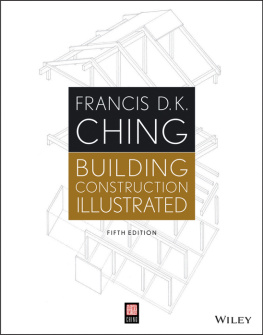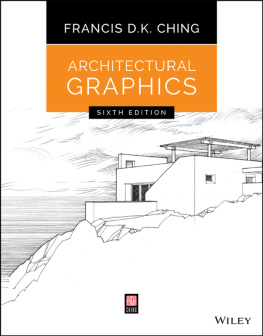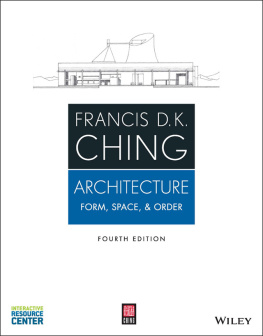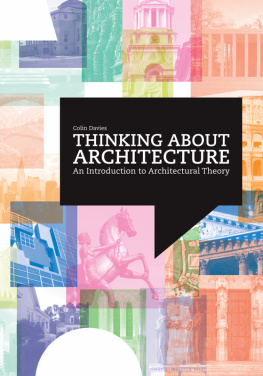CONTENTS
ARCHITECTURE Form, Space, & Order
Third Edition
Copyright 2007 by John Wiley & Sons, Inc. All rights reserved
Wiley Bicentennial Logo: Richard J. Pacifico
Published by John Wiley & Sons, Inc., Hoboken, New Jersey
Published simultaneously in Canada
No part of this publication may be reproduced, stored in a retrieval system, or transmitted in any form or by any means, electronic, mechanical, photocopying, recording, scanning, or otherwise, except as permitted under Section 107 or 108 of the 1976 United States Copyright Act, without either the prior written permission of the Publisher, or authorization through payment of the appropriate per-copy fee to the Copyright Clearance Center, 222 Rosewood Drive, Danvers, MA 01923, (978) 750-8400, fax (978) 646-8600, or on the web at www.copyright.com . Requests to the Publisher for permission should be addressed to the Permissions Department, John Wiley & Sons, Inc., 111 River Street, Hoboken, NJ 07030, (201) 748-6011, fax (201) 748-6008, or online at http://www.wiley.com/go/permission .
Limit of Liability/Disclaimer of Warranty: While the publisher and the author have used their best efforts in preparing this book, they make no representations or warranties with respect to the accuracy or completeness of the contents of this book and specifically disclaim any implied warranties of merchantability or fitness for a particular purpose. No warranty may be created or extended by sales representatives or written sales materials. The advice and strategies contained herein may not be suitable for your situation. You should consult with a professional where appropriate. Neither the publisher nor the author shall be liable for any loss of profit or any other commercial damages, including but not limited to special, incidental, consequential, or other damages.
For general information about our other products and services, please contact our Customer Care Department within the United States at (800) 762-2974, outside the United States at (317) 572-3993 or fax (317) 572-4002.
Wiley also publishes its books in a variety of electronic formats. Some content that appears in print may not be available in electronic books. For more information about Wiley products, visit our web site at www.wiley.com .
Library of Congress Cataloging-in-Publication Data:
Ching, Frank, 1943
Architecture--form, space, & order / Francis D.K. Ching. -- 3rd ed.
p. cm.
Includes bibliographical references and index.
ISBN 978-0-471-75216-5 (pbk.)
1. Architecture--Composition, proportion, etc. 2. Space (Architecture) I. Title.
NA2760.C46 2007
720.1--dc22
2007002358
PREFACE
The original edition of this study introduced the student of architecture to form and space and the principles that guide their ordering in the built environment. Form and space are the critical means of architecture that comprise a design vocabulary that is both elemental and timeless. The second edition continued to be a comprehensive primer on the ways form and space are interrelated and organized in the shaping of our environment, and was refined by editing the text and incorporating diagrams for greater clarity, adding selected examples of architectural works, expanding the sections on openings, stairways and scale, and finally, by including a glossary and an index to designers. This third edition continues to illustrate the ways the fundamental elements and principals of architectural design manifest themselves over the course of human history but adds an electronic component to introduce the aspects of time and movement to the exposition of elements and principles.
The historical models in this book span time and cross cultural boundaries. While the juxtaposition of styles may appear to be abrupt at times, the diverse range of examples is deliberate. The collage is intended to persuade the reader to look for likenesses among seemingly unlike constructions and bring into sharper focus the critical distinctions that reflect the time and place of their making. Readers are encouraged to take note of additional examples encountered or recalled within the context of their individual experiences. As the design elements and principles become more familiar, new connections, relationships, and levels of meaning may be established.
The illustrated examples are neither exhaustive nor necessarily the prototypes for the concepts and principles discussed. Their selection merely serves to illuminate and clarify the formal and spatial ideas being explored. These seminal ideas transcend their historical context and encourage speculation: How might they be analyzed, perceived, and experienced? How might they be transformed into coherent, useful, and meaningful structures of space and enclosure? How might they be reapplied to a range of architectural problems? This manner of presentation attempts to promote a more evocative understanding of the architecture one experiences, the architecture one encounters in literature, and the architecture one imagines while designing.
ACKNOWLEDGEMENTS
I am indebted to the following people for their invaluable contributions to the original edition of this work: Forrest Wilson, whose insights into the communication of design principles helped clarify the organization of the material, and whose support made its publication possible; James Tice, whose knowledge and understanding of architectural history and theory strengthened the development of this study; Norman Crowe, whose diligence and skill in the teaching of architecture encouraged me to pursue this work; Roger Sherwood, whose research into the organizational principles of form fostered the development of the chapter on ordering principles; Daniel Friedman, for his enthusiasm and careful editing of the final copy; Diane Turner and Philip Hamp, for their assistance in researching material for the illustrations; and to the editorial and production staff at Van Nostrand Reinhold, for their exceptional support and service during the making of the first edition.
For the second edition, my appreciation goes to the many students and their teachers who have used this book over the years and offered suggestions for its improvement as a reference and tool for study and teaching. I want to especially thank the following educators for their careful critique of the first edition: L. Rudolph Barton, Laurence A. Clement, Jr., Kevin Forseth, Simon Herbert, Jan Jennings, Marjorie Kriebel, Thomas E. Steinfeld, Cheryl Wagner, James M. Wehler, and Robert L. Wright.
In preparing this third edition, I am thankful to Michele Chiuini, Ahmeen Farooq, and Dexter Hulse for their thoughtful reviews of the second edition. While I have attempted to incorporate much of their wise counsel, I remain solely responsible for any deficiencies remaining in the text. I especially want to express my gratitude to the editorial and production staff at John Wiley & Sons for their invaluable support and encouragement, and to Nan-ching Tai for his creative contributions and technical assistance in preparing the electronic component of this third edition.
To Debra, Emily, and Andrew, whose love of life it is ultimately the role of architecture to house.
INTRODUCTION
Architecture is generally conceiveddesignedand realizedbuiltin response to an existing set of conditions. These conditions may be purely functional in nature, or they may also reflect in varying degrees the social, political, and economic climate. In any case, it is assumed that the existing set of conditionsthe problemis less than satisfactory and that a new set of conditionsa solutionwould be desirable. The act of creating architecture, then, is a problem-solving or design process.













